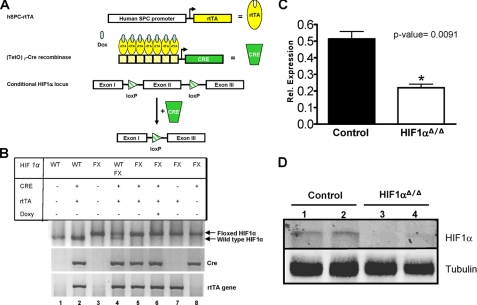FIGURE 1.
Lung-specific, doxycycline-inducible deletion of HIF1α in triple transgenic mice. A, transgenic mice were generated that express three transgenes, the rtTA protein under the control of the human SP-C promoter, the (tetO)7-CMV-Cre recombinase transgene in which Cre recombinase expression is controlled by the (tetO)7-CMV promoter, and the conditional HIF1α locus. In the presence of doxycycline and rtTA, Cre recombinase is induced in a lung-specific manner and facilitates the homologous recombination of the loxP sites flanking exon 2 thus inactivating the HIF1α locus. B, agarose gel showing the genotyping results for all the combinations of the three transgenes. Floxed HIF1α size is 274 bp and wild-type HIF1α is 240 bp. C, qRT-PCR results for HIF1α mRNA from triple transgenic mice in the absence (Control) and presence (HIF1aΔ/Δ) of doxycycline (14 day in utero exposure). Values are the average of five separate animals per group. D, Western blot analysis for HIF1α from lungs of triple transgenic mice in the absence (Control) and presence (HIF1αΔ/Δ) of doxycycline (14 day in utero exposure). Blots were also probed with a tubulin-specific antibody to demonstrate equal loading. Two independent animals from both groups are shown (1-4).

